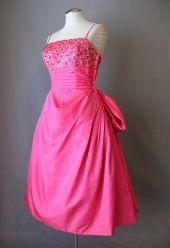
I posted this message on all my EBay listings a couple of weeks ago, and since then, I've been receiving several emails a day asking "Why? Why are you closing your EBay store?" The outpouring of support and commiseration has been overwhelming, and I thank you all from the bottom of my heart.
There are several reasons I am moving away from selling on EBay, not the least of which are what I consider poor business decisions on EBay's part. That being said, here are my reasons, in no particular order:

1. You met
my first granddaughter a few months ago. She is now 6 months old, and is the sweetest bundle of fun and blessings any woman could ask for. When my daughter calls to say, "Mom, HELP!", I drop everything and go, which means I need a bit more flexibility in my life.
2. My new website,
www.coutureallure.com has been very successful since the launch in July, and I will be devoting most of my work efforts to filling it with the best vintage I can find for you.

3. I'm almost too embarassed to show this to you. This has to change. This is about 1/3 of my office/storage space. Over the past year or so, I was very lucky to receive calls for several large estate clean-outs. I also bought a LOT of vintage at various auctions. I ended up feeling overwhelmed, unfocused, and stressed. I was working 6 days a week, not sleeping well, and always thinking about the business. That's no way to live.
About a month ago, I had a life-changing, light bulb moment in which I suddenly stopped and asked myself, "What are you doing? STOP!". The next day, I went through everything in storage, and donated 25 large trash bags full of ordinary, boring, or damaged vintage to the local thrift store. Much of the remainder is top notch vintage that went back into storage to be listed on the website. The rest was divided into piles by era, which I've been selling off in large lots on EBay, and to local dealers.
At the end of that day, I suddenly felt a huge weight lift from my shoulders and I've been sleeping really well. Each large lot that goes out the door, goes with an enthusiastic wave goodbye and my best wishes. My mailman will get a huge basket of homemade cookies when the last big box goes.
4. And then there is EBay. EBay has made several policy changes in the last few months that negatively impact sellers on their site. Not only have their fees increased dramatically, but now they are forcing buyers to use PayPal only. No more money order payments will be allowed on the site starting in October. And don't get me started about their new Best Match search experience!
As a buyer, have you noticed there is far less vintage being offered on EBay? That's because sellers are leaving the site in large numbers. Have you noticed you can't find anything on EBay anymore? That's because EBay's new search returns lots of irrelevant items and you have to weed through things you're not interested in to find a few that you are.
I will still list an item or two for auction on EBay from time to time, and will probably always have a few Fixed Price items available, but I'm closing my EBay store within the next month. Please bookmark the new website at
www.coutureallure.com, and be sure to sign up for
our newsletter while you're there!
 This ad, found in the July 1951 issue of Vogue magazine is not for the suit, but for the wool it was made from. This suit was made by Roxspun from "Miroque...Worsted with a vertical rib. One of Miron's unique new texturals, 100% Virgin Wool."
This ad, found in the July 1951 issue of Vogue magazine is not for the suit, but for the wool it was made from. This suit was made by Roxspun from "Miroque...Worsted with a vertical rib. One of Miron's unique new texturals, 100% Virgin Wool."




.jpg)
.jpg)



























































